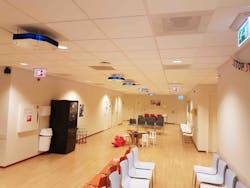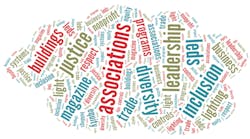Sinking a whole set of teeth into its recently sharpened ultraviolet lighting bite, Signify today announced plans for a wide range of UV-C products aimed at killing the coronavirus SARS-CoV-2 on surfaces, on objects, and in the air. It also said it had acquired a germicidal lighting specialist firm, and gave details of UV-C factory ramp-ups in Europe, Asia, and North America.
The company described 12 families of luminaires and chambers that between them target the virus that causes COVID-19 in varied settings such as offices, schools, gyms, hospitals, hotels, restaurants, retail stores, warehouses, and public transportation. For example, supermarkets can use UV-C tunnels to treat shopping carts; schools and offices can use upward-pointing, ceiling-mounted UV-C to treat circulating air; and clothing retailers can disinfect tried-on garments in a dressing room’s UV-C chamber before hanging them for sale again in the shop.
On a phone call with journalists this morning , Signify’s Harsh Chitale said the products will help meet what he called a “surging demand for disinfection.” Chitale is leader of Signify’s Digital Solutions division, essentially the former Professional group. It emerged earlier this year to sell products and services to the commercial, industrial, and public sectors.
All of the products use decades-old mercury discharge technology, not LED. They emit at the 254-nm wavelength, which is part of the UV-C band of ultraviolet radiation. Ultraviolet radiation is regarded as invisible light. It has a shorter wavelength than visible light, with the C-band being the shortest and A-band the longest.
The 254-nm wavelength is extremely harmful to skin and eyes, so manufacturers such as Signify and Osram are building them with safety features, such as sensors that detect when people have walked into a room where the light is emitting UV radiation down. In enclosed chambers and tunnels for disinfecting objects, the chambers and tunnels serve as UV shields.
The launch of the new UV-C lines comes two months after Signify CEO Eric Rondolat signaled the company’s intentions to ramp up production of UV disinfection products.
The company paved the way for today’s unveiling when it disclosed last week that a Boston University lab determined that a Signify 254-nm UV-C tube lamp deactivated 99% of a sample of SARS-CoV-2 within 6 seconds. The same lamp would kill almost 100% at a higher dose over 25 seconds, the researchers determined.
The 99% and higher would apply to the light’s use on surfaces and objects, Chitale told LEDs Magazine. It would also apply to air circulated over the upward-pointing UV-C unit in settings such as an office or school, although the overall percentage in the room’s air would be lower depending on the air circulation and how much of the air actually reached the lighting system, he said.
“Over a period of time, all the air keeps getting clean,” Chitale said. While the percentage would tend to be lower than 99% because of bottom air that has not yet circulated up, “it’s still substantially cleaner than what it is otherwise,” he said.
While UV-C can be effective as a coronavirus zapper, UV-B and UV-A do not kill the virus, although they are effective against bacteria. (For those wondering: UV-C gets filtered out of sunlight before it reaches Earth by the ever-important ozone layer. UV-B and UV-A complete the journey, causing sunburn and possible skin cancer, yet they are less immediately dangerous to humans than UV-C).
Signify is ramping up production of the light sources at a factory in Pila, Poland and in China. It is adding production capacity for luminaires, chambers, and other systems in North America, Europe, and Asia.
To strengthen its UV portfolio, Signify said it acquired all assets from Dutch specialist company Germicidal Lamps & Applications (GLA) including intellectual property, product designs, tools, and contracts. The acquisition does not appear to include GLA’s staff, although the company’s founder is working with Signify, Chitale told LEDs. Signify did not disclose the acquisition price, which Chitale described as “not material.”
Meanwhile, Chitale reiterated, as CEO Rondolat said last week, that LED technology in its current state is not viable for killing the virus.
“On LED at 254 nm, as of now, we see that the power that comes out is still not adequate,” Chitale told LEDs. While Signify is not ruling out LED in the long run at 254 nm, its current LED disinfection products tend to be in the UV-A band. Last week, Rondolat noted that at 254 nm, “If we were using LED, it would be totally incompatible from a cost perspective and from a consumption perspective,” and explained that LED would require 50× more light sources than mercury.
Experts such as Bob Karlicek, director of the Center for Lighting Enabled Systems & Applications (LESA) at Rensselaer Polytechnic Institute, foresee significant progress and interest in LED development at 254 nm. You can get a full slate of facts about UV-C from Karlicek in the on-demand webcast.
Osram has said it is working on a 254-nm LED product.
Signify’s Chitale also told LEDs, as Rondolat did last week, that the company is investigating an even shorter wavelength product that could be effective against coronavirus while also being safer to humans than 254-nm UV-C. So-called “far UV,” often at 222 nm, has been the subject of research at Columbia University, Kobe University, and elsewhere. Acuity Brands has partnered with Ushio in the area, using excimer lamps as an add-in to LED luminaires for visible white light.
Signify is also considering other disinfection lighting technologies not in the UV spectrum.
“We look at all the technologies,” Chitale said. “We have a play in all of them and we continue to explore all of them. So we do have right now solutions developed around ultraviolet technology.
“Having said that, what we see today is 254 (using mercury) is proven, it’s effective, it’s available, it’s commercially affordable and hence in the current environment, when people want to use solutions to make a place safer as we go to the new normal, it’s the only solution which can immediately be made available. We are concentrating on ramping up our capacity and solutions on UV-C. At the same time, we will continue to explore solutions with LED as well as far UV. And as and when we think that they are ready to introduce in the market to a wider scale, you will hear more about that from us.”
For now, though, it’s all systems go with 254-nm mercury lamps. Chitale declined to identify users and customers except to say that a leading lighting supplier to food retailers in North America has picked up the line, that some large companies are deploying the lights in offices, and that hotels in India are using it.
Signify has also sold some on an OEM basis to other lighting manufacturers.
MARK HALPER is a contributing editor for LEDs Magazine, and an energy, technology, and business journalist ([email protected]m).
For up-to-the-minute LED and SSL updates, why not follow us on Twitter? You’ll find curated content and commentary, as well as information on industry events, webcasts, and surveys on our LinkedIn Company Page and our Facebook page.







